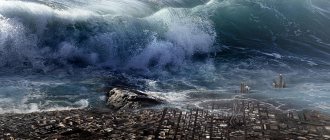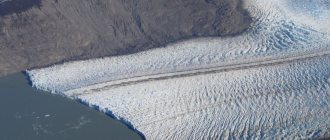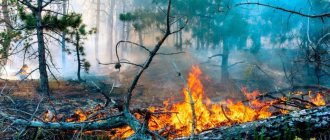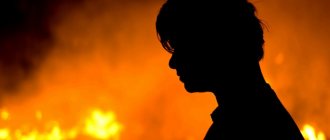Natural disasters, due to their suddenness, are among the most dangerous and destructive emergency situations. Often, due to the too rapid development of a disaster, it is not possible to notify the population in advance, or there is very little time left for complete evacuation. In such cases, a person can survive only thanks to his knowledge. Let's consider what correct actions of the population during a tsunami can increase the chances of survival, and how to receive a minimum of injuries and injuries.
Rules of human behavior during a tsunami
emergency evacuation tsunami
A TSUNAMI is a dangerous natural phenomenon consisting of sea waves that arise mainly as a result of the upward or downward displacement of extended sections of the seabed during underwater and coastal earthquakes.
SIGNS OF A TSUNAMI. A natural warning signal of the possibility of a tsunami is an earthquake. Before a tsunami begins, as a rule, the water recedes far from the coast, exposing the seabed for hundreds of meters and even several kilometers. This low tide can last from a few minutes to half an hour.
The movement of the waves can be accompanied by thunderous sounds that are heard before the approach of the tsunami waves. A sign of an approaching natural disaster may be a change in the usual behavior of animals, which sense dangers in advance and tend to move to higher places.
- · Monitor tsunami forecast messages and be aware of warning signs.
- · Remember and explain to your family the tsunami warnings for your area.
- · Have a tsunami plan in advance.
- · Make sure that all your family members, co-workers and acquaintances know what to do during a tsunami.
- · Assess whether your home or place of work is located in an area of possible tsunami action.
- · Remember that the most dangerous places are river mouths, narrowing bays, and straits.
- · Know the boundaries of the most dangerous areas and the shortest routes to safe places.
- · Make a list of documents, property and medicines to be removed during evacuation. It is advisable to put property and medicines in a special suitcase or backpack.
- · Consider the evacuation procedure in advance. Decide where your family will meet if there is a tsunami warning.
- · During daily activities at home and at work, do not clutter corridors and exits with bulky things, cabinets, bicycles, strollers.
- · Make sure all passages are clear for quick evacuation.
- · Learn the rules of behavior in case of tsunami danger.
- · Consider the sequence of your actions if you find yourself indoors, in open areas, or in water during a tsunami.
- · Prepare a place in your apartment in advance where, in case of a quick evacuation, put the necessary documents, clothing, personal belongings, and a two-day supply of non-perishable food.
- · Support community tsunami preparedness programs and actively participate in planting forest shelterbelts along the coast.
- · Support efforts by local authorities to strengthen bays with breakwaters and coastal dikes.
WHAT TO DO DURING A TSUNAMI
- · When a tsunami warning is received, respond immediately.
- · Use every minute to ensure your personal safety and the protection of those around you. You may have anywhere from a few minutes to half an hour or more, so if you act calmly and thoughtfully, you can increase your chances of staying safe from the effects of a tsunami.
- · If you are indoors, leave it immediately, after turning off the lights and gas, and move to a safe place.
- · If you are driving a car, follow in a safe direction, picking up running people along the way.
- · If it is impossible to take refuge in a safe place, when there is no time left to move, climb as high as possible to the upper floors of the building, close the windows and doors. If possible, move to the most secure building.
- · If you are sheltering indoors, remember that the safest areas are considered to be places near main internal walls, near columns, in corners formed by main walls.
- · Remove nearby objects that could fall, especially glass ones.
- · If you do find yourself outdoors, try to climb a tree or take cover in a place that is less susceptible to impact. As a last resort, you need to cling to a tree trunk or a solid barrier.
- · Once in the water, get rid of your shoes and wet clothes, try to cling to objects floating on the water. Be careful, as the wave can carry large objects and their debris with it. After the arrival of the first wave, prepare to meet the second and subsequent waves, and if possible, leave the dangerous area.
- · If necessary, provide first aid to victims.
WHAT TO DO AFTER A TSUNAMI
- · Wait for the alarm to clear. Return to your original location after making sure that there have been no high waves at sea for two to three hours.
- · When entering a house, check its strength and the safety of windows and doors. Make sure there are no cracks in the walls and ceilings, and no erosion of the foundations. Carefully check for gas leaks in the premises and the condition of the electrical lighting.
- · Notify the Emergency Situations Commission about the condition of your home. Actively join the team in carrying out rescue and other emergency operations in damaged buildings, searching for victims and providing them with the necessary assistance.
”
This is interesting: Explosion: types, damaging factors, severity of injuries
Why do tsunamis happen?
In case of an earthquake, beware of a tsunami
During an earthquake, be vigilant - even a small earthquake can cause a dangerous tsunami. If you are close to the coast and feel tremors or see unusual waves, immediately try to move to higher ground. You may not have time to do this if you wait for a notification.
What to do when you hear a tsunami warning?
Even if you do not feel any tremors, in case of warning, immediately leave the coastal area to a safe place.
Don't expect the water to recede
Often before a tsunami, water moves away from the shore, but this phenomenon does not always occur. Don't wait until you can see the tsunami - it may already be too late.
What is a tsunami?
Tsunami (Japanese 津波 IPA: where 津 - “port, bay”, 波 - “wave”). Translated from Japanese it means “big wave in the harbor” or simply “wave in the harbor”. Tsunamis are long waves generated by a powerful impact on the entire thickness of water in the ocean or other body of water. They have spatial scales from several hundred meters to several hundred kilometers. The speed of propagation of tsunami waves (c) is described by the Lagrange :
с=√gh,
where h is the depth of the ocean;
g is the acceleration of free fall.
What not to do during a tsunami?
To begin with, we will tell you what not to do during a tsunami so that you do not make serious mistakes.
Firstly, you cannot stand in fascination and look at a huge wave, rooted to the spot. This recommendation may seem strange to you: who would even think of standing and watching? But, as practice shows, many do just that. Either out of horror, or out of interest. Either they don’t understand that this wave is capable of reaching the shore.
This is a real photo of the tsunami in Thailand. First, the ocean exposed its bottom: the water went kilometers from the shore - and people began to collect shells. And then it was too late...
Secondly, if the tsunami is already close, simply running will not help, because the wave moves at a speed of 800 km per hour (airplane speed). But the closer to the shore, the slower it becomes: the speed drops to 80 km per hour. This is the speed of the car.
Thirdly, if the tsunami is still far away, but is already known, most likely you have no more than 15-20 minutes to escape. Therefore, instead of packing, we use the time to escape. We take only what is necessary. Or we don't take anything. Save not things, but lives!
Fourthly, you should not run near river beds: it is the river beds that will flood first during a tsunami, because the sea has communication with them.
Classification
Tsunami classifications are most often found according to three criteria.
If we consider the phenomenon from the point of view of the reasons for its origin, then it happens:
- formed by underwater earthquakes;
- formed by coastal earthquakes;
- formed by eruptions of underwater and island volcanoes;
- formed by landslides on the seabed.
This natural phenomenon is also classified by intensity, which ranges from 1 to 6 points and gives an idea of the types of waves according to their height and destructive power:
- 1 point – waves do not cause concern and are recorded only by instruments;
- 2 points – coastal flooding occurs;
- 3 points – wave height up to two meters, refers to medium intensity. Capable of slightly destroying coastline structures and throwing light vessels onto land;
- 4 points – wave height up to three meters, considered strong. Buildings are subject to moderate destruction, and loss of life is possible. Small ships are washed ashore and then washed out to sea;
- 5 points – wave height from 8 to 23 meters, very strong. Human casualties and destruction of buildings are recorded, the extent of which depends on the distance of the coastline. Even large ships end up on land;
- 6 points – rogue waves. The consequences of the cataclysm are large human losses and a completely flooded coastal area.
A destructive natural phenomenon is formed during earthquakes from 6 points on the Richter scale. The height of the tsunami depends on seismic activity and the distance of the epicenter from the coast and sea surface.
The third classification consists of five groups and is based on the number of victims:
- Group 1 – no fatalities;
- Group 2 - up to 50 people;
- Group 3 – 50–100 people;
- Group 4 – 100–1000 victims;
- Group 5 – more than 1000 dead.
The most catastrophic and deadly tsunami is considered to be the 2004 Indian Ocean tsunami, in which more than 300 thousand people died or went missing.
Harbingers
A distinctive feature of the phenomenon is suddenness. But if you are more careful, you can notice the characteristic harbingers of a tsunami, signaling the approach of a catastrophe.
Warning factors:
- the booming sounds of tremors;
- in winter - the grinding of ice;
- a sudden ebb, exposing the bottom for several kilometers, or a high tide;
- restless behavior of animals trying to leave the coast.
Any earthquake on land or under water is a harbinger of an impending disaster. When a low tide occurs at an unusual time, it is necessary to take urgent measures for rescue, and not to examine the seabed. The waves approaching the shore make a sound similar to distant thunder. According to the description of an eyewitness to the 1952 tragedy in Severo-Kurilsk, before the collapse of the water masses, a sound comparable to the movement of a train was heard.
Animals that intuitively sense changes in the electrostatic field can predict a tsunami. The Japanese have learned to determine the approach of earthquakes by the behavior of fish in an aquarium. They start hitting the walls and jumping out. Any sea fish leaves the coastal zone, rushing to the depths. Snakes, small rodents, and birds react quickly to a tsunami.
Even a few signs of approaching trouble can help you take the necessary safety measures in time.
This is interesting: Fire evacuation training
Causes
Earthquakes on the ocean floor or near the coast, as well as underwater or island volcanic activity trigger the formation of a natural phenomenon. As a result of a crustal fracture, tectonic plates move: the lower one tends to the surface, and the upper one tries to maintain a stable position. As a result, a massive oscillating column of water is displaced, from which giant waves are formed. Seismic activity at the bottom causes a destructive natural phenomenon only if the source is located from the sea surface at a depth of no more than 20 km.
Fractures, movement of sections of the seabed in the vertical plane, volcanic eruptions are the main causes of tsunamis, causing the occurrence of 85% of them. But huge landslides, which cause strong disturbance of water masses, can also lead to the generation of giant waves.
Humans also make their contribution to the formation of pulsations in the water column by conducting deep-sea tests of atomic weapons. Such activities are formally prohibited, but this does not stop participants in the arms race seeking to confirm their combat readiness.
And the last factor that can provoke huge waves is cosmic phenomena, such as a meteorite hitting the ocean.
It is worth noting that the occurrence of a tsunami does not always depend on one factor, more often on several at once.
Actions in the event of a tsunami threat or occurrence
February 8, 2021
“ACTIONS IN THE EVENT OF A TSUNAMI AND A TSUNAMI” A tsunami is a dangerous natural phenomenon, which is sea waves that arise mainly as a result of the upward or downward displacement of extended sections of the seabed during underwater and coastal earthquakes. Once formed in any place, a tsunami can spread at high speed (up to 1000 km/h) over several thousand kilometers. The height of the wave in the area of origin is from 0.1 to 5 m. When reaching shallow water, it increases sharply - from 10 to 50 m. Huge masses of water thrown ashore lead to flooding of the area, destruction of buildings and structures, power and communication lines, roads , bridges, piers, as well as to the death of people and animals. An air wave propagates in front of the water shaft, acting similarly to an explosive one and destroying buildings and structures. The tsunami may not be isolated. Very often this is a series of waves rolling onto the shore at intervals of 1 hour or more. Signs of a tsunami. A natural warning signal of the possibility of a tsunami is an earthquake. Before a tsunami begins, the water, as a rule, recedes far from the coast (up to several kilometers). This low tide can last from a few minutes to half an hour. The movement of the waves is accompanied by thunderous sounds that are heard before the tsunami approaches. Sometimes, before a wave, the coast is flooded with a water “carpet”. Cracks may appear in the ice cover off the coast. A sign of an approaching natural disaster may be a change in the usual behavior of animals, which sense danger in advance and strive to move to higher places. Residents in tsunami-prone areas should take early action to reduce the impact of the disaster. To do this, you need to: monitor tsunami forecast messages, keeping in mind their harbingers; remember and explain to family members the tsunami warning signals established for your region; think through a plan of action during a tsunami in advance; draw up a list of documents, property and medicines taken out during evacuation (it is advisable to put property and medicines in a special suitcase or backpack); during daily activities at home and at work, do not clutter corridors and exits with bulky items, cabinets, bicycles, strollers; ensure that all passages are clear for quick evacuation; learn the rules of behavior in case of danger of a tsunami. A tsunami can be warned by the “Attention everyone!” signal transmitted by sirens, intermittent beeps of enterprises and vehicles, upon hearing which, turn on the radio, TV (local program guide) and listen to information and instructions. The message usually provides the estimated time of arrival of the tsunami and specific coastal settlements that are in danger, the procedure for action and evacuation of the population. When evacuating, you need to take with you warm, preferably waterproof, things, food, documents and money, warn your neighbors about the evacuation, and also turn off the electricity. When leaving home, act in accordance with a predetermined procedure or instructions received on radio or television. If the evacuation is carried out on foot, you should provide assistance to the sick, elderly and children, if by transport - show organization and attention to others, give up your seat in the vehicle to those unable to move independently. While in the room, go up to the upper floors, close all doors and move to a safe place (openings of main internal walls, corners formed by main walls). The main thing is to leave rooms that have windows or other openings on the side from which the wave is moving, and hide from it behind a solid wall. It is necessary to protect yourself from falling debris or heavy furniture, stay away from windows, glass partitions, as well as heavy objects that can tip over or move. The general rule when a tsunami arrives is not to run out of the building. The wave raging outside and the debris floating next to the building pose a great danger. If the occupied premises have obviously low strength and are more likely to be destroyed by a wave, if there is time, it is necessary to move to a more durable building. When personally observing tsunami harbingers or receiving information about them from other people, you should remember that there is time left for rescue, measured in tens of minutes. It is necessary to immediately, warning others and those oncoming about the threat, providing assistance to the sick, disabled, elderly and children, without worrying about property, head to the nearest mountains, hills, other elevated places and climb no less than 30-40 m. The way up should run along the slopes of hills, and not along the valleys of streams and rivers flowing into the sea, since their beds themselves can serve as a road for a water shaft rushing against their current. If there is no hill nearby, move away from the coast at a distance of at least 2-3 km. When meeting a wave outside a building, it is better to climb onto the trunk of a strong tree, hide behind a natural rock barrier or a strong separate concrete wall, clinging to them. If you are in a place where there are a large number of structures or other objects around, try to move to another one due to the danger of hitting them. If you have little time to move, use it to remove clothes and shoes. Once in the wave, you need to first take a breath, group yourself and cover your head with your hands. Having emerged to the surface, you should throw off wet clothes and shoes, prepare for the return movement of the wave, and, if necessary, use objects floating or rising above the water. Having survived one wave, the period of time before the next must be used to exit to a safe place. The population, who independently left or evacuated to safe places in advance, should remain there for 2-3 hours after the first wave, until all waves have passed and a signal for permission to return is received. Upon returning, before entering the building, you must make sure that there is no threat of its collapse due to damage and erosion, as well as short circuits in electrical circuits.
Consequences
Huge waves carrying a colossal charge of energy are capable of demolishing all obstacles in their path. The destructive power of a tsunami, from which it is difficult to escape, directly depends on the direction and speed of the wave, the relief, and the contour of the coastline. Despite the fact that the speed of the wave decreases when approaching a flat shore, the consequences do not become milder. Water penetrates deep into the island or mainland over a long distance. The consequences of a tsunami are divided into primary and secondary.
Primary factors include:
- destruction of fragile buildings by a shock air wave;
- flooding of agricultural land, erosion of the foundations of residential and industrial buildings and structures;
- loss of life;
- throwing ashore ships moored at piers and anchored in roadsteads, pulling parked cars into the sea;
- destruction of structures, port facilities, rocks.
Particularly affected are people living in densely populated settlements located near the top of wedge-shaped bays or on the gently sloping ocean shore.
Violation of the integrity of industrial facilities leads to the manifestation of secondary consequences: fires occur as a result of fuel spills from sea vessels, damage to oil storage facilities and processing plants. An environmental disaster is caused by the release of radiation due to accidents at nuclear power plants. Domestic gas leakage occurs due to damage to communications, and the risk of chemical pollution of the environment increases.











